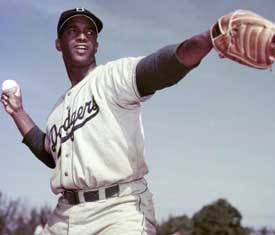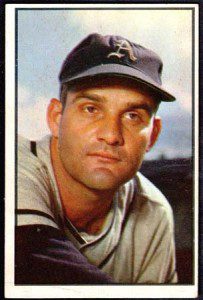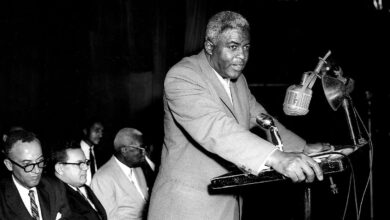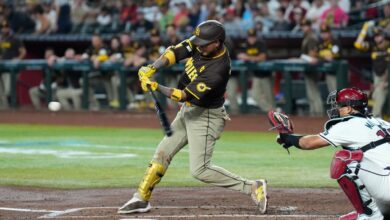

1952 National League vs. American League: Joe Black and Harry Byrd
The 1952 rookie class is a war of two right-handers: an inconsistent career journeyman fireballer versus a popular former Negro Leaguer who appeared in the 1952 Fall Classic with the Brooklyn Dodgers. Harry Byrd played seven seasons in the bigs and is perhaps best remembered as the only Philadelphia Athletic to ever win ROTY honors. Joe Black, on the other hand, is the fifth former Negro Leaguer to win ROTY after Willie Mays, Sam Jethroe, Don Newcombe, and Jackie Robinson.
Both would have relatively brief playing careers and flame out after 1957.
American League: Harry Byrd, pitcher, Philadelphia Athletics
Byrd pitched six games for the Philadelphia Athletics in 1950, all in relief. The numbers weren’t pretty: 10.2 IP, 25 hits, 20 runs, three home runs, and nine walks. It was plenty enough to send him back to the minors, and he spent the entire 1951 season with the Savannah Indians of the Class A South Atlantic League. Harry not only pitched well, but also was the ace of the staff, with 18 wins in 31 starts, with a 3.59 ERA in 248 innings pitched.
Maintaining his rookie status, the 27-year-old from Darlington, South Carolina, won 15 games for the A’s in 1952. Despite also losing 15 games, Byrd threw 228.1 innings in 28 starts, with 15 complete games and a solid 3.31 ERA. The 1952 Philadelphia Athletics also had the American League’s Most Valuable Player in southpaw Bobby Shantz,(24-7, 2.48 ERA, 27 complete games) and the league’s leading hitter in first base man Ferris Fain (.327 BA, .438 OBP, 43 2B). Despite the obvious talent on the club, the team finished in fourth place at 79-75, 16 games behind the New York Yankees.
Byrd never achieved the same success again at the major-league level although he did win a total of 26 games in his first two seasons. He won 11 games in 1953, but also lost 20. He lead the league in starts (37), earned runs allowed (145), and most dubiously, batters hit by pitch (he nailed 14 guys). His ERA also rose to 5.51.
Following the 1953 campaign, he was traded to the Yankees in an 11-man deal. He was 9-7 for New York in 1954, with an impressive 2.99 ERA. Byrd was traded three more times, making stops in Baltimore, the south side of Chicago and Detroit. He pitched 37 games for the Tigers his last season, going 4-3 with a 3.36 ERA. Just as Byrd became the only Rookie of the Year in Philadelphia Athletic team history, the franchise picked up and moved to Kansas City in 1955.
Career stats: 46-54, 4.35 ERA, 187 games, 381 Ks in 827.2 IP.

National League: Joe Black, pitcher, Brooklyn Dodgers
Black had a dazzling rookie year in the big leagues for the original boys of summer. Coming primarily out of the pen as one of the team’s (and league’s) best pitchers, Black appeared in 56 games for the Dodgers in 1952. He was 15-4 with a 2.15 ERA and saved 15 games. He led the NL in games finished with 41, and finished third in the league in winning percentage (.789)
Leading up to his 1952 rookie season with the Dodgers, Black played in the Negro Leagues with the Baltimore Elite Giants. Teammates who would later join Black in Brooklyn included Roy Campenella and 1953 NL Rookie of the Year Jim Gilliam.
His Negro League career started out slowly due to the service during World War II. From 1943 to 1945, Black only factored in eight decisions for Baltimore. He went 4-8 in 1946 and 9-9 in 1947, before finally breaking out the following season, going 10-5.
He was signed by Brooklyn in late 1950 as a 26-year-old, pitching well both in the Cuban Winter League and for the St. Paul Saints of the American Association. He made the big-league team out of spring training in 1952 and made his major-league debut on May 1 versus the Cubs. He tossed one inning with a couple of strikeouts.
Despite being a dominant reliever out of the bullpen in 1952, Black was asked by manager Charlie Dresson to start in the ’52 Fall Classic. (Ironically, Black had only made two starts that season, winning both). In the ’52 seven-game World Series classic versus the Yankees, Black made three starts. He earned the win in game one, with a six-hit complete game. The October 10 4-2 Brooklyn victory put Black into the record books, as he became the first African-American pitcher in baseball history to win a World Series game.
Black pitched fairly well in game four, allowing one run on three hits in seven innings. It was not enough, however, as the Yankees’ Allie Reynolds pitched a complete-game, four-hit, 10-strikeout, shutout masterpiece for the Bombers.
Finally, in his third start, Black was the losing pitcher in game seven. He allowed three runs on a walk and a strikeout. He gave up two long balls, one a first-inning solo shot to Mickey Mantle, and the second, another solo bomb by Gene Woodling. Woodling’s homer chased Black after 5.1 innings. With the 4-2 Yankees win, the Bums of Flatbush would have to wait three more years for their first and only World Series title in Brooklyn.
Black was a unanimous choice for ROTY, finishing with 19 first-place votes. However, finishing second with three votes was New York Giants pitcher Hoyt Wilhelm. The future Hall of Fame reliever also won 15 games (15-3), leading the NL in winning percentage (.833), ERA (2.43), appearances (71 games), and ERA+ (152).
Joe finished third in MVP voting behind Cubs slugger Hank Sauer (.270 BA, 37 HR, and 121 RBIs) and Phillies pitcher Robin Roberts (28-7, 2.59 ERA).
Although he pitched again in the World Series the following season (one inning in relief versus the Yanks, allowing one run on a Game 5 homer to 1951 AL Rookie of the Year Gil McDougald), Black never attained the same success the remainder of his major-league career. He lost velocity on his fastball and the break in his curve, prompting a trade to the Cincinnati Reds in June 1955. Between the Dodgers and the Reds, Black went 6-2 with a 4.05 ERA. His ERA grew to 4.52 in 32 relief appearances in 1956, and after just seven games with the Washington Senators, Black was released on November 25, 1957.
In six seasons lifetime, Black was 30-12 with a 3.91 ERA. He appeared in 172 games (only 16 starts!), while striking 222 in 414 innings pitched.
A long-time resident of Phoenix, Black, later in his life, did community relations work for the Arizona Diamondbacks. He passed away in 2002, and the Arizona Fall League MVP trophy is now named in his honor.
Once again, the scoring system for the Rookie of the Year battle is three points for the best rookie year, five points for the best career.
Rookie of the year goes to …
Joe Black. He was the most consistent arm on the 1952 Dodgers squad, while Byrd was more of a complimentary piece to an underperforming team laden with talent.
Rookie career goes to …
Joe Black. He came up through a Dodgers system that had broken the color barrier with Jackie Robinson, while making history of his own.
The NL is starting to pull away in the Rookie race, 24-8!
See the results for 1949, 1950, and 1951.
Next up for 1953: Jim Gilliam of the Dodgers vs. Harvey Kuenn of the Tigers.




